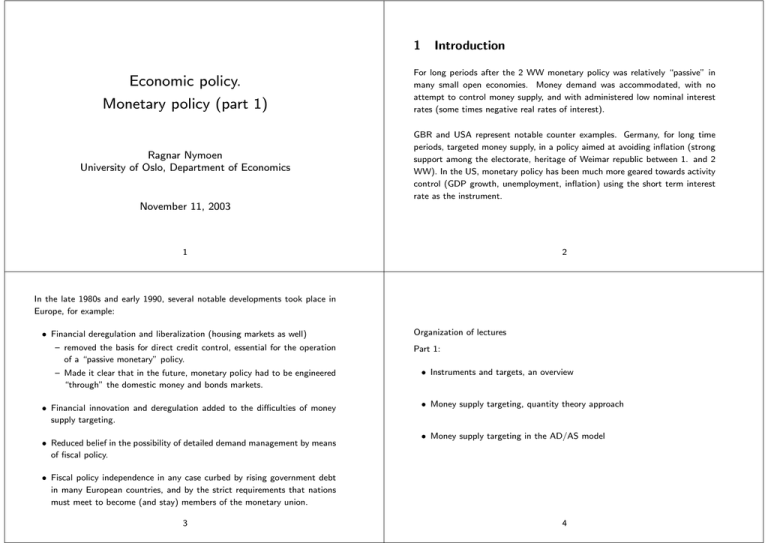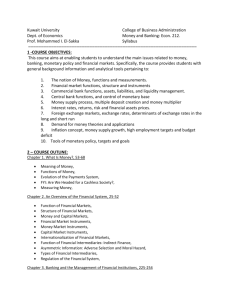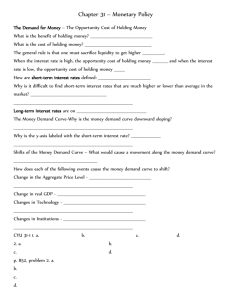Economic policy. 1 Introduction
advertisement

1 Economic policy. Monetary policy (part 1) Ragnar Nymoen University of Oslo, Department of Economics Introduction For long periods after the 2 WW monetary policy was relatively “passive” in many small open economies. Money demand was accommodated, with no attempt to control money supply, and with administered low nominal interest rates (some times negative real rates of interest). GBR and USA represent notable counter examples. Germany, for long time periods, targeted money supply, in a policy aimed at avoiding inflation (strong support among the electorate, heritage of Weimar republic between 1. and 2 WW). In the US, monetary policy has been much more geared towards activity control (GDP growth, unemployment, inflation) using the short term interest rate as the instrument. November 11, 2003 2 1 In the late 1980s and early 1990, several notable developments took place in Europe, for example: • Financial deregulation and liberalization (housing markets as well) — removed the basis for direct credit control, essential for the operation of a “passive monetary” policy. — Made it clear that in the future, monetary policy had to be engineered “through” the domestic money and bonds markets. • Financial innovation and deregulation added to the difficulties of money supply targeting. • Reduced belief in the possibility of detailed demand management by means of fiscal policy. Organization of lectures Part 1: • Instruments and targets, an overview • Money supply targeting, quantity theory approach • Money supply targeting in the AD/AS model • Fiscal policy independence in any case curbed by rising government debt in many European countries, and by the strict requirements that nations must meet to become (and stay) members of the monetary union. 3 4 2 Instruments and targets, an overview Reading (part 1 and part 2) : Monetary policy: Targets and instruments B&W ch 20, 20.5 in particular. Instruments ⇓ OEM ch 3.4 and 10.1 Rødseth: Choosing a monetary policy target. Short-term interest rates, reserve requirements, market operations, interventions Intermediate target Indicator with a reliable connection with target ⇓ e.g., money supply, exchange rate, inflation forecast Ultimate target Inflation, exchange rate 5 6 Monetary targets are relative to other policy goals Targets are model dependent Note that it is not obvious whether e.g., the rate of foreign exchange is an intermediate target or an ultimate target. It depends on political priorities (not the subject of economics), but also on the beliefs about how the economy operates. Hence, for example a fixed exchange rate may be given up because of a lack of belief in the possibility of reaching the target. This does not preclude that the exchange rate can be an intermediate target, as when Gjedrem indicates that higher inflation in Norway can be attained by weakening the krone by interventions. In academic economics, and in central banks, “beliefs” are formalized by models. Hence targets are model dependent. The intermediate (or “quasi”) target of monetary policy are relative to the ultimate targets. Specifically, a (good/useful) intermediate target should be highly correlated with the ultimate target. The ultimate monetary policy targets are in their turn only instruments in achieving the goals of economic policy with higher priority, such as 1. High private consumption 2. Provision of public goods, sufficient quantity and quality 3. Securing (the conditions for) economic growth 4. Low unemployment 5. Equity (e.g., “fair” income distribution) 7 8 It is a dictum of monetary policy that monetary instruments cannot influence real variables, as implied by a vertical long run Phillips curve. However, flexible inflation targeting or exchange rate targeting include reference to output or employment. This is a concession to the view that over a period of some years, if not in the long-run, the strive for monetary target attainments cannot be separated from other (real) targets. Shows (again!) that the choice of both targets and instruments are model dependent, in particular dependant upon the government’s (Central Bank’s) view about how monetary policy affects the economy–the transmission mechanism. 3 Money supply targeting, the quantity theory approach. The first rationale for money supply targeting is the quantity theory of money, saying (somewhat loosely) that M × velocity = P × Y. If the velocity of money is constant, and Y is given, and M can be targeted, then this relationship links the price level (and inflation), directly to the intermediate target. A recognized problem with this approach is that the velocity of money is not constant over time, and its change is difficult to predict. This alone reduces the quality of M as an intermediate target. A modernized version of this approach is still with us, and is based on so called inversion of the domestic money demand function for period t: To illustrate how two views of the transmission mechanism influence monetary policy choices we consider two versions of money supply targeting. Mt = L(Yt, it) Pt 9 10 Taking logs, and differencing with respect to time gives (notation from B&W): In the 1980s, several countries attempted to control inflation via controlling the money supply. πt = µt − ηgt (8.4) where µt is the rate of growth of money-supply and gt is the growth rate of Y , and η is ElY M/P = LY (Yt, it)Y /L(Yt, it). However, these policies proved unsatisfactory in practise. Several possible explanation for the failure of money supply targeting Given that 1. µt can be controlled by the government, 2. η is constant (and known), 1. With a fixed exchange rate it may be difficult to sterilize in order to avoid endogenous movements in M 2. Even if exogenous, difficult to control (or predict) money supply through instruments (narrow money and reserve requirements). 3. gt is exogenous and 3. η, need not be constant 4. it is constant, 4. is η a short-run of long-run effect? What about dynamic multipliers? (8.4) provides a rationale for choosing the growth rate of money supply as the intermediate target and the rate of inflation as the ultimate target. 11 5. gt not exogenous (wrt M ) from period to period 12 4 and, ultimately: 1 L(Yt, it) Mt is an all to simple model of the transmission mechanism. It involves inversion of causality, i.e., using a demand for money relationship to determine money P , a procedure which is highly dubious empirically (easy to test econometrically, and data rejects). Pt = Analogy to simple regression between yt and xt.. With yt as dependent variable OLS gives b, and the reversed regression gives b0. From OLS algebra: 2 b × b0 = ryx hence if b is stable for different samples lengths, and the degree of correlation changes, the inverted regression cannot also be stable. Invalidates inversion of estimated stable money demand functions. 13 Money supply targeting in the AD-AS model The case for the money supply as the target can also be made in the AD-AS framework. Consistent with OEM, domestic market operations represent the instrument (this is implicit in the following) In a float regime (i.e., floating exchange rate) the short-run AD curve is shifted rightward by a monetary expansion. Formally, from M M , Y )−π̄)+Ḡ+P CA(Y, Y ∗, (S(i∗, , Y )/S−1+π−π ∗)σ−1) P P the (vertical) shift is given by Y = C(Ω̄, Y −T̄ )+I(q̄, i( dπ dM (Iρi M + P CAσ S M σ−1)/P ¯ ¯ P P > 0. ¯AD,float,short = −P CAσ σ−1 In the long-run only nominal effects: S & and P %. Long-run elasticities 1%. In the fixed exchange rate regime there is no shift in the AD schedule. 14 Role of capital mobility: Baseline model assumes perfect capital mobility. If we (instead) assume imperfect capital mobility we have the following modifications: 1. Only minor in float case. Money market analysis as before, and positive relationship between i and S in the foreign exchange marker (same as the downward sloping “Ei-curve” in the OEM model). 2. In a fixed exchange rate regime sterilization is now possible. i is determined in the domestic market. Hence, we can think in terms of a functional relationship between monetary stance and interest rate similar to The AD-AS model, which is a much better model of the transmission mechanism than the quantity theory, re-install money supply targeting as a possible operational target for monetary policy. However, M affects π and Y via the interest rate. In that sense more using the interest rate moves the instrument closer to the ultimate inflation target. This is the approach taken in modern monetary policy. M , Y ), i M ≤ 0, iY ≥ 0. P P In that case i & also in this regime inducing a positive vertical shift in the AD curve (albeit smaller) than in the float case. Difficult to say in which regime the short increase in Y is largest. i = i( 15 16 5 Modern monetary policy: flexible exchange rate targeting or inflation rate targeting. Part 2 of lecture. 17









